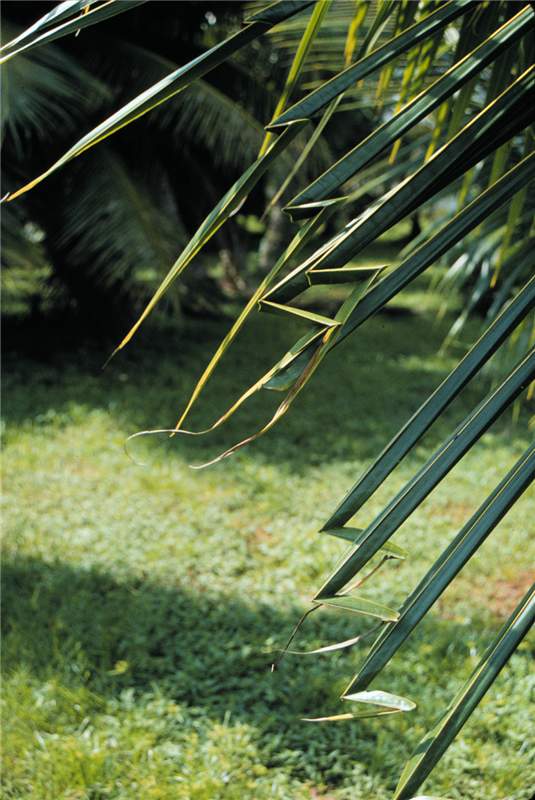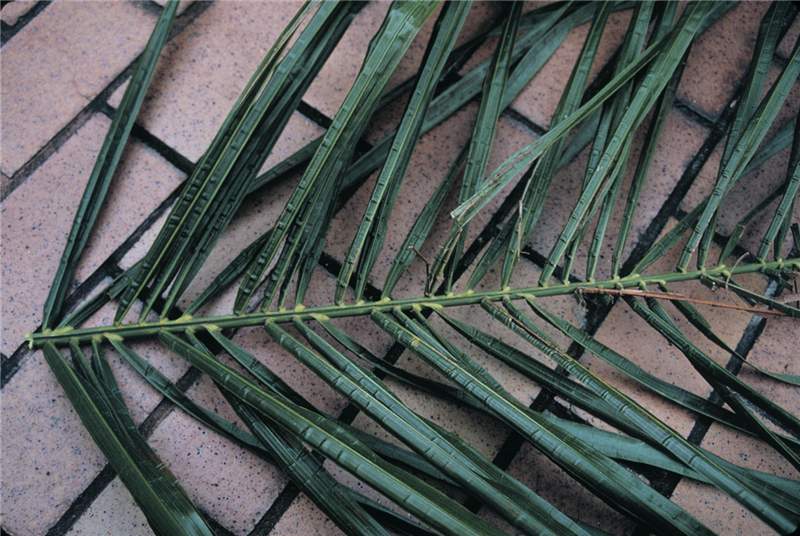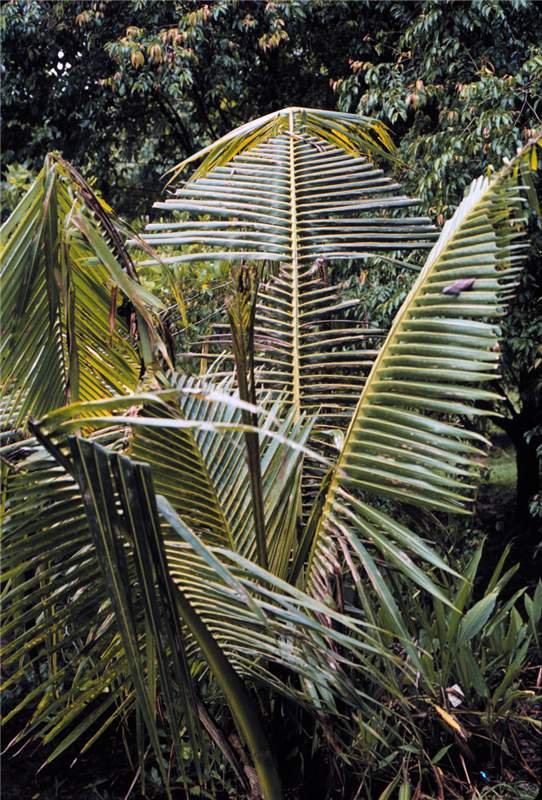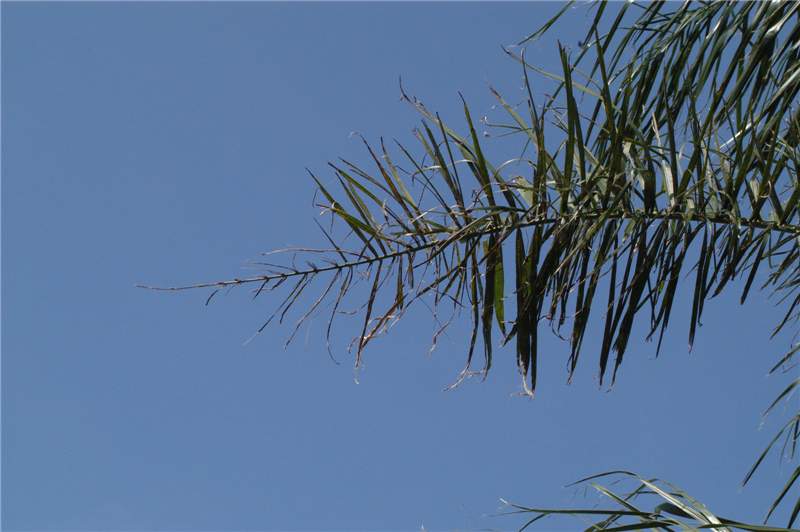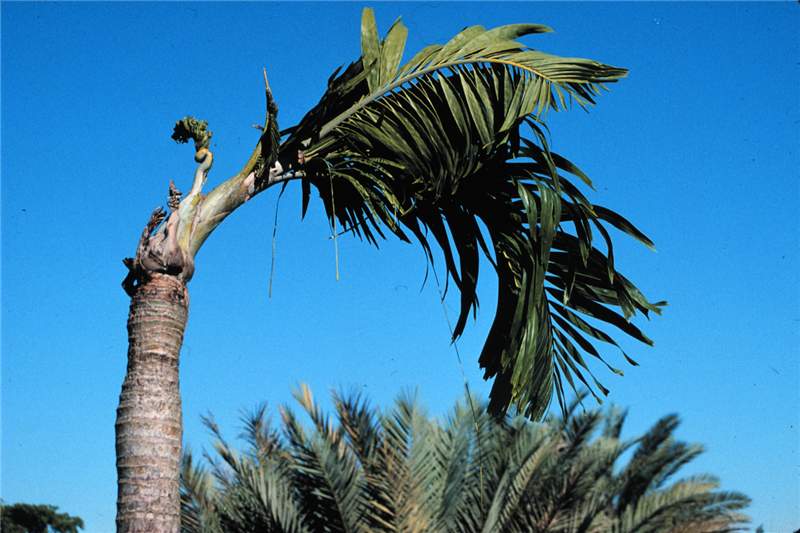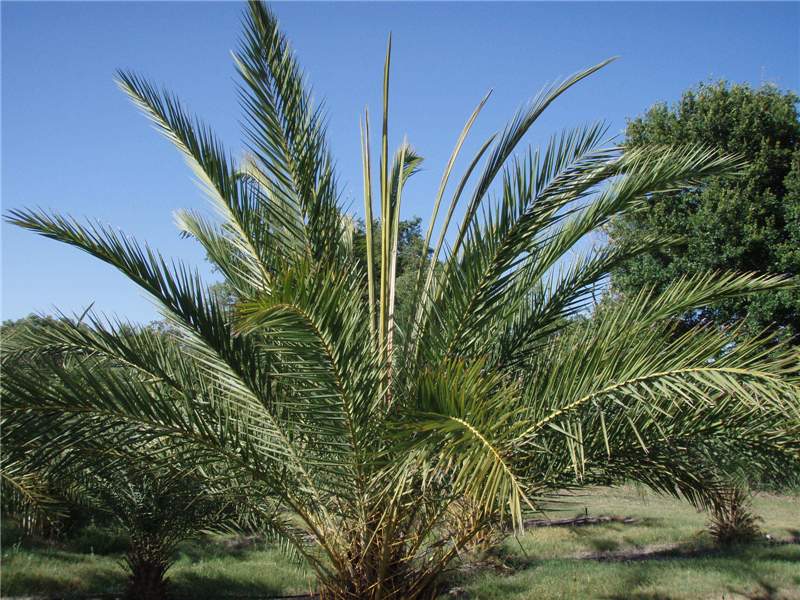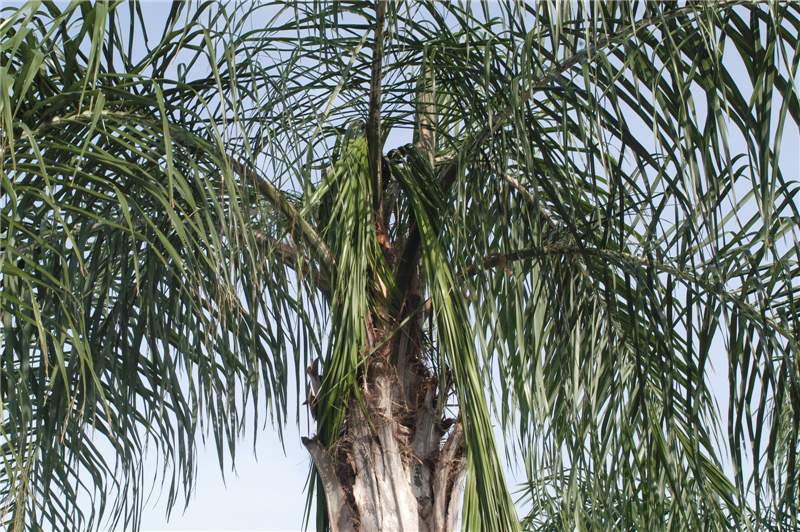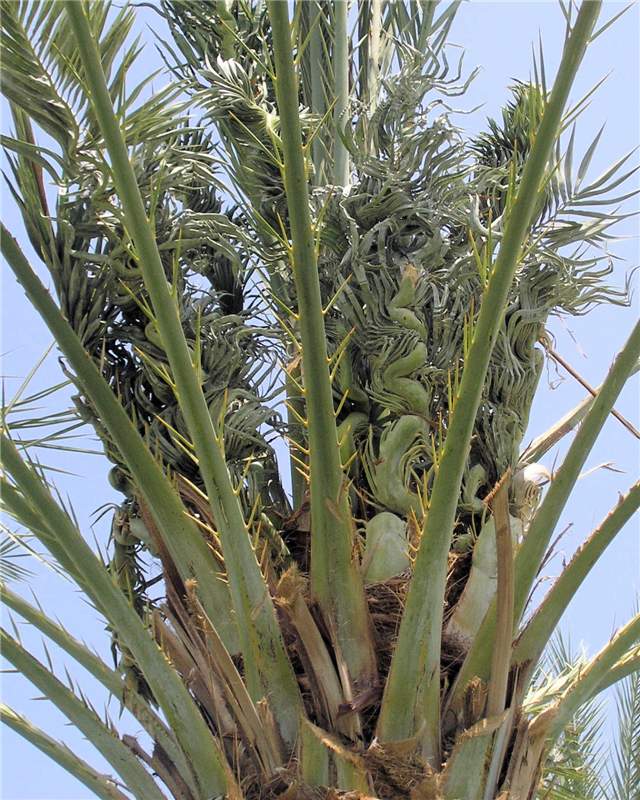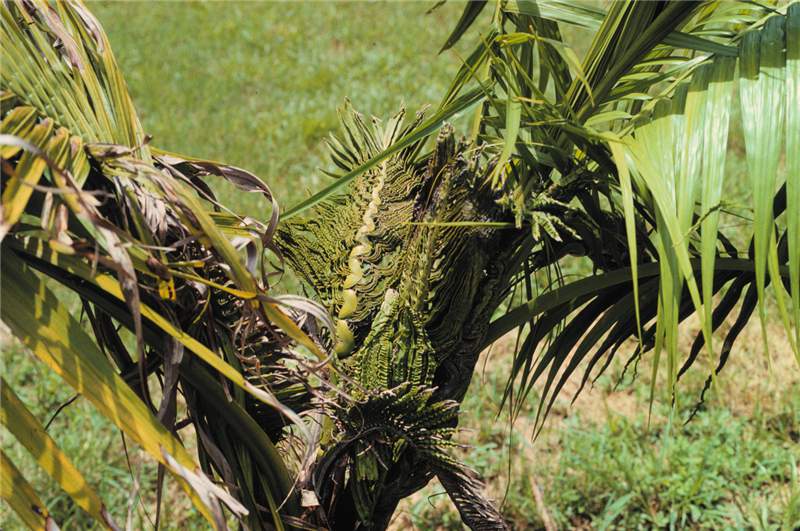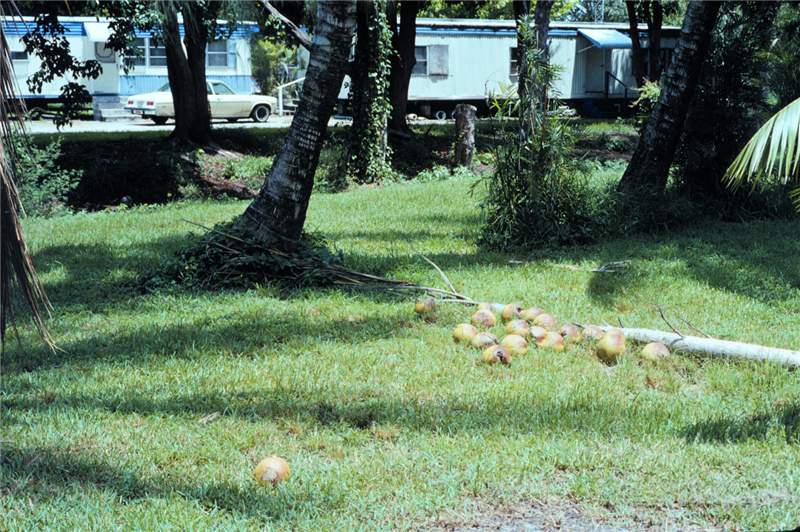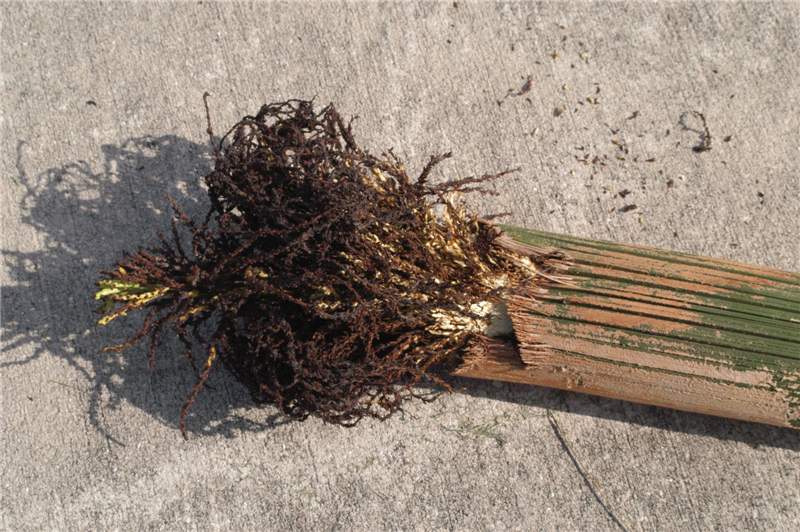Boron Deficiency
|
Figure 2. Zigzag shaped leaflet tips ("hookleaf") in Cocos nucifera is caused by a mild and temporary B deficiency. Photo by T.K. Broschat
|
|
Figure 1. Transverse puckering in Syagrus romanzoffiana, a symptom of mild B deficiency. Photo by T.K. Broschat
|
|
Figure 4. Leaf truncation in Cocos nucifera caused by periodic temporary B deficiency. This pattern was the result of heavy rainfall events approximately every 10 days during the development of the leaf in the center. Photo by T.K. Broschat
|
|
Figure 3. Leaf tip of Syagrus romanzoffiana devoid of leaflets, a symptom of B deficiency. Photo by T.K. Broschat
|
|
Figure 6. Trunk bending in Adonidia merrillii caused by B deficiency. Photo by T.K. Broschat
|
|
Figure 5. Multiple unopened spear leaves in Phoenix sylvestris caused by chronic B deficiency. Photo by T.K. Broschat
|
|
Figure 8. New leaves growing downward in Syagrus romanzoffiana caused by boron deficiency. Photo by T.K. Broschat.
|
|
Figure 7. Severe epinasty in Roystonea regia caused by chronic B deficiency. Photo by T.K. Broschat
|
|
Figure 10. Corrugated leaf of queen palm caused by B deficiency. Photo by T.K. Broschat
|
|
Figure 9. Branching in Syagrus romanzoffiana caused by boron deficiency. Photo by T.K. Broschat
|
|
Figure 12. Crumpled ("accordion-leaf") young leaves of Phoenix dactylifera caused by a chronic and severe B deficiency. Note that the youngest leaf is emerging normally, indicating that this palm is recovering. Photo by T.K. Broschat
|
|
Figure 11. Crumpled new leaves ("accordion-leaf") on Heterospathe elata caused by severe B deficiency. Photo by T.K. Broschat.
|
|
Figure 14. Premature fruit drop in Cocos nucifera caused by B deficiency.Photo by T.K. Broschat
|
|
Figure 13. Inflorescence necrosis on B-deficient Sygrus romanzoffiana. Photo by T.K. Broschat
|
Symptoms
Boron deficiency causes a wide array of symptoms, not only among species of palms, but also within a single species. Symptoms always occur on newly emerging leaves, but remain visible on these leaves as they mature and are replaced by younger leaves.
One of the earliest symptoms of B deficiency on Dypsis lutescens and Syagrus romanzoffiana is transverse translucent streaking or puckering (Fig. 1) on the leaflets. In many species including Cocos nucifera, Elaeis guineensis, and S. romanzoffiana, mild B deficiency may be manifested as sharply bent leafletleaflet:
divisions of pinnate leaves
tips, commonly called "hookleaf" (Fig. 2). These sharp leafletleaflet:
divisions of pinnate leaves
hooks are quite rigid and cannot be straightened out without tearing the leaflets. In some species, these "hooks" drop off. Another symptom associated with chronic B deficiency in S. romanzoffiana is the production of weak, narrow leaflets towards the tips of newly emerging leaves. These leaflets often drop off, leaving the rachisrachis:
the axis of a leaf beyond the petiole or an extension of the petiole into the leaf blade
tip devoid of leaflets (Fig. 3).
Boron deficiency can be very transient in nature, often affecting a developing leaf primordium for a very short period of time (e.g., 1 to 2 days). This temporary shortage of B can cause necrosisnecrosis:
dead tissue, usually desiccated and brown to gray in color
of the primordial spear leafspear leaf:
the younges emerging leaf that has not yet opened
for a distance of about 1 to 2 cm. When such leaves eventually expand, this "point" necrosisnecrosis:
dead tissue, usually desiccated and brown to gray in color
affects the tips of all leaflets intersected by that necroticnecrotic:
see necrosis
point, the net result being the appearance of a blunt, triangular truncation of the leaf tip. This pattern can be repeated as many as 3 times during the development of a single leaf of Cocos nucifera (about 5 weeks) (Fig. 4).
One of the most common symptoms of B deficiency is the failure of newly emerging spear leaves to open normally. They may be tightly fused throughout their entire length, or the fusion can be restricted to basalbasal:
closest to the point of attachment
or distaldistal:
farthest from the point of attachment
parts of the spear leafspear leaf:
the younges emerging leaf that has not yet opened
. In a chronic state, multiple unopened spear leaves may be visible at the apex of the canopycanopy:
the cluster of leaves borne at the tip of the stem
(Fig. 5).
Perhaps the most unusual symptom of chronic B deficiency is the tendency for the entire crowncrown:
see canopy
to bend in one direction (Figs. 6 and 7). This is one form of epinastyepinasty:
increased growth of the upper surface of a plant part, such as a leaf, resulting in a downward bending of the part
that can also cause twisting of petioles and leaves or sharp bends in the petiolepetiole:
leaf stem
, resulting in a new leaf growing downward along the trunk (Fig. 8). These epinastic symptoms are believed to be caused by a B deficiency-induced decrease in indoleacetic acid oxidase activity and therefore excessive auxinauxin:
plant hormone that regulates the amount, type, and direction of plant growth
concentrations within the leaves. Boron deficiency can even cause branching in species that do not normally branch (Fig. 9).
Boron deficiency in its acute form produces yet other symptoms. Often leaves emerge greatly reduced in size and crumpled in a corrugated fashion (accordion-leaf) (Figs. 10 and 11). Palms may grow out of these symptoms or the deficiency can kill the meristemmeristem:
the growing region of a plant, a special area of undifferentiated cells wherein new cells and organs are developed
(Fig. 12). Boron-deficient palms often abort their fruits prematurely and inflorescences may have extensive necrosisnecrosis:
dead tissue, usually desiccated and brown to gray in color
near their tips (Figs. 13 and 14).
May be confused with
Manganese deficiency in Cocos nucifera produces symptoms similar to those of B deficiency, but no other common deficiency produces symptoms that could be confused with those of B deficiency. Lethal yellowing also causes inflorescence necrosisnecrosis:
dead tissue, usually desiccated and brown to gray in color
and premature fruit drop, however, the calyx end of fallen coconuts from LY-infected Cocos nucifera will be blackened, whereas coconuts from B-deficient trees will not have this blackened end.
Cause
Boron is readily leached through most soils, with a single heavy rain event temporarily leaching most available B out of the root zone. When this leaching stops, B released from decomposing organic matter will again provide adequate B for normal palm growth in most cases. Thus, mild, transient symptoms of B deficiency are believed to be caused by leaching. On the other hand, in drier climates B binds tightly to soils as they dry, and soil drying is believed to be the cause of more chronic B deficiencies in palms.
Occurrence
Boron deficiency is very widespread on palms growing in wet climates throughout the world, but can also occur in desert situations. It was almost unknown in Florida until a series of high rainfall summers occurred in the mid 2000s, when it became a widespread and serious problem on palms within the state. Boron deficiency has been observed in container-grown palms, but it is rather rare in this environment.
Additional comments
Because B deficiency can be highly transient in nature and because deficiencies affect only leaf primordia developing within the budbud:
a common term for meristem; the specialized growing region of a plant containing undifferentiated cells from which new cells and organs are developed
area, leaf analysis is not particularly useful. Leaf analysis informs you of the B status of the palm 4 or 5 months ago when the sampled leaf itself was in the critical developmental stage within the budbud:
a common term for meristem; the specialized growing region of a plant containing undifferentiated cells from which new cells and organs are developed
. The B status of the palm may have changed considerably one way or another during 4 or 5 months since the affected leaf became old enough to sample. Thus, leaf analysis, or even leaf symptoms, unless the deficiency is chronic (regularly occurring), cannot tell you about the current B status of a palm.


